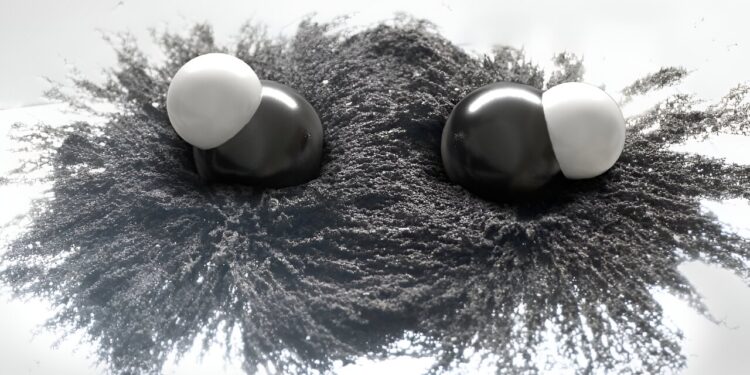Two diatomic molecules lie in an intermolecular potential, represented here by iron powder indicating the field lines by which two molecules are linked. Credit: © Christoph Hohmann, MCQST
A team of experimentalists from the Max Planck Institute for Quantum Optics (MPQ) and theorists from the Chinese Academy of Sciences (CAS) succeeded for the first time in populating and stabilizing a new type of molecules, called molecules tetratomics linked to the field. . These “supermolecules” are so fragile that they can only exist at ultracold temperatures. Their existence had long been suspected but had never been demonstrated experimentally – until now.
The polyatomic molecules created in this new study are composed of more than two atoms and have been successfully cooled to 134 nanokelvins, more than 3,000 times colder than the temperature of previously created tetraatomic molecules. This achievement not only constitutes a novelty in molecular physics, but also a significant advance in the study of ultra-cold exotic matter. The research is published in Nature.
About twenty years ago, American theoretical physicist John Bohn and his colleagues predicted a new type of bonding between polar molecules: if the molecules carry an asymmetrically distributed charge – what physicists call polarity – they can combine in a field electrical to form weakly bound “supermolecules”. “.
The behavior of these polar molecules can be compared to that of compass needles inside a hard shell. When close together, the compass needles experience a stronger pull than the Earth’s magnetic field and they point toward each other instead of lining up to the north.
A similar phenomenon can be observed with polar molecules which, under specific conditions, can form a single bound state via electrical forces. Their bond is somewhat reminiscent of a dancing couple holding each other closely while constantly maintaining a certain distance.
The bound state of supermolecules is much weaker than classical chemical bonds, but at the same time it has a much longer range. Supermolecules share bond length over distances several hundred times longer than normally bonded molecules.
Due to this long-range nature, these supermolecules are very sensitive: if the electric field parameters are only slightly changed at a critical value, the forces between the molecules change dramatically – a phenomenon called “field-related resonance” . “This allows researchers to flexibly vary the shape and size of molecules with a microwave field.
A game in three parts: From diatomic molecules to tetraatomic molecules
Ultracold polyatomic molecules contain a rich internal structure that offers exciting new possibilities in cold chemistry, precision measurements and quantum information processing. However, their high complexity compared to diatomic molecules poses a major challenge to the employment of conventional cooling techniques such as direct laser cooling and evaporative cooling.
Researchers at MPQ’s NaK Lab, led by Dr. Nature-discoveries published in recent years, which have been crucial to finally meeting this challenge.
First, in 2021, researchers in this laboratory invented a new technique for cooling polar molecules using a high-power rotating microwave field, setting a new low temperature record: 21 billionths of a degree above from absolute zero to minus 273.15 degrees Celsius.
A year later, the researchers succeeded in creating the conditions necessary to observe the binding signature between these molecules for the first time in diffusion experiments. This provided the first indirect evidence of the existence of these long-predicted exotic constructs.
Today, there is even direct evidence since researchers managed to create and stabilize these supermolecules during their experiment. Imaging of these “supermolecules” revealed their p-wave symmetry, a unique feature crucial in realizing topological quantum materials, which in turn may be relevant for fault-tolerant quantum computing.
“This research will have immediate and far-reaching implications,” says Xing-Yan Chen, Ph.D. candidate and first author of the paper. “As the method is applicable to a wide range of molecular species, it allows the exploration of a much larger variety of ultracold polyatomic molecules. In the future, it may enable the creation of even larger, long-lived molecules. longer life, which would be particularly interesting for precision metrology or quantum chemistry.
“We achieved these results also thanks to our close collaboration with Professor Tao Shi and his team at CAS,” adds Dr Luo, principal investigator of the experiment. “Our next goal is to further cool these bosonic ‘supermolecules’ to form a Bose-Einstein condensate (BEC), in which the molecules move together. This prospect holds significant potential for our fundamental understanding of quantum physics. What is more surprising is that by simply adjusting a microwave field, a BEC of “supermolecules” can be transformed into a new quantum fluid of fermionic molecules preserving the particular symmetry of the p-wave.”
More information:
Xing-Yan Chen et al, Tetraatomic molecules linked to an ultracold field, Nature (2024). DOI: 10.1038/s41586-023-06986-6
Provided by the Max Planck Society
Quote: First tetraatomic supermolecules produced at nanokelvin temperatures (January 31, 2024) recovered on January 31, 2024 on
This document is subject to copyright. Except for fair use for private study or research purposes, no part may be reproduced without written permission. The content is provided for information only.



